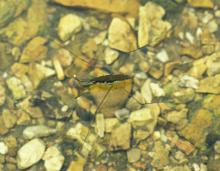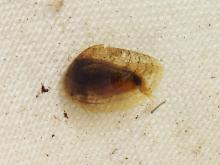Aquatic Invertebrates
Media

Species Types
Scientific Name
Aquarius remigis; also species in the genus Gerris
Description
Water striders are eye-catching. Water-repellant hairs on the hind and middle legs allow these nimble insects to skate on the surface of the water.
Media

Species Types
Scientific Name
Dugesia, Planaria, and other genera
Description
Unlike their parasitic cousins in the flatworm group, turbellarians, or planarians, are tiny carnivores or detritus-eaters that glide smoothly across submerged leaves and other objects.
Media

Species Types
Scientific Name
Beetles in the family Psephenidae
Description
Water penny beetle larvae are truly nifty aquatic invertebrates that bring out the child in all of us. Some of them really do look like pennies!
Media

Species Types
Scientific Name
Cyclestherida, Laevicaudata, and Spinicaudata (orders or suborders)
Description
Clam shrimp have their carapace shaped like a pair of clam shells and they can close it tightly when disturbed. But they are not clams: they have tiny, jointed shrimplike legs and bristly, feathery antennae.
Media

Species Types
Scientific Name
Pisidium, Sphaerium, and Musculium spp.
Description
Fingernail clams, also called pill clams or pea clams, are members of a family of small to tiny freshwater clams that are common but rarely noticed. They occur in a variety of aquatic habitats.
Media

Species Types
Scientific Name
Corbicula fluminea
Description
The Asian clam is a nonnative, invasive species that lives in a variety of aquatic habitats. It has thick shells with distinctly ridged, concentric rings and a yellowish-brown to dark brown shell covering.
See Also
About Aquatic Invertebrates in Missouri
Missouri's streams, lakes, and other aquatic habitats hold thousands of kinds of invertebrates — worms, freshwater mussels, snails, crayfish, insects, and other animals without backbones. These creatures are vital links in the aquatic food chain, and their presence and numbers tell us a lot about water quality.





















